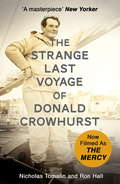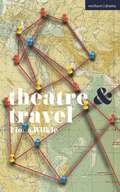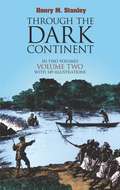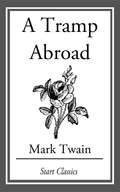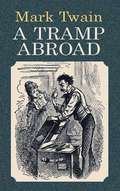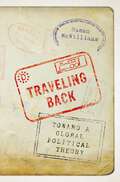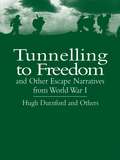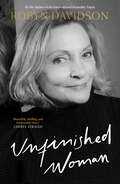- Table View
- List View
The Strange Last Voyage of Donald Crowhurst: Now Filmed As The Mercy (Sailmate Ser.)
by Ron Hall Nicholas Tomalin'A masterpiece.' New Yorker'Wholly riveting, brilliantly researched.' Evening Standard'A meticulous investigation into the seeds of disaster... fascinating, uncomfortable reading.' Sunday Times In 1968, Donald Crowhurst was trying to market a nautical navigation device he had developed, and saw the Sunday Times Golden Globe round the world sailing race as the perfect opportunity to showcase his product. Few people knew that he wasn't an experienced deep-water sailor. His progress was so slow that he decided to short-cut the journey, while falsifying his location through radio messages from his supposed course.Everyone following the race thought that he was winning, and a hero's welcome awaited him at home in Britain. But on 10 July 1968, eight months after he set off, his wife was told that his boat had been discovered drifting in mid-Atlantic. Crowhurst was missing, assumed drowned, and there was much speculation that this was one of the great mysteries of the sea. In this masterpiece of investigative journalism, Nicholas Tomalin and Ron Hall reconstruct one of the greatest hoaxes of our time. From in-depth interviews with Crowhurst's family and friends and telling excerpts from his logbooks, Tomalin and Hall develop a tale of tragic self-delusion and public deception, a haunting portrait of a complex, deeply troubled man and his journey into the heart of darkness.
Theatre and Travel (Theatre And)
by Fiona WilkieWhat is the relationship between touring and other kinds of theatre work? How should theatre circulate, and how are we to understand this circulation? What impact do tour routes have beyond the dissemination of what is on stage? Whose travel stories are told within the theatre, and by whom? This concise study argues that we should pay more attention to how, why and where theatre travels. Moving away from prevailing metaphors of 'strolling players' and 'the circuit', this volume examines in more detail what theatre is doing when it tours, and why it matters.Enlivened with a wide range of examples – from Ancient Rome to internet livestreams, solo tours to national theatres, and Shakespeare to post-apocalyptic fiction – Theatre & Travel distinguishes between different versions of theatre touring to uncover both the possibilities and the inequalities that it entails. Proposing that travel is central to our understanding of theatre, the book asks what changes might need to happen to enable theatre to travel better in the world.
Through the Dark Continent: Vol. 2
by Henry M. StanleyPerhaps best known as the intrepid adventurer who located the missing explorer David Livingstone in equatorial Africa in 1871, Henry Morton Stanley (1841-1904) played a major role in assembling the fragmented discoveries and uncertain geographical knowledge of central Africa into a coherent picture. He was the first European to explore the Congo River; assisted at the founding of the Congo Free State, and helped pave the way for the opening up of modern Africa.In this classic account of one of his most important expeditions, the venerable Victorian recounts the incredibly difficult and perilous journey during which he explored the great lakes of Central Africa, confirming their size and position, searched for the sources of the Nile, and traced the unknown Congo River from the depths of the continent to the sea. Accompanied by three Englishmen and a crew of Africans, Stanley left Zanzibar in 1874. He traveled to Lake Victoria, which he circumnavigated in his boat, the Lady Alice. Almost immediately, illness, malnutrition and conflicts with native tribes began to decimate his followers. Nevertheless, the explorer pushed on, also circumnavigating Lake Tanganyika, which he determined to be unconnected with the Nile system. Finally in 1876, Stanley was ready to undertake "the grandest task of all" — exploring the Livingstone (Congo) River. He sailed down the vast waterway to the lake he called Stanley Pool, then on to a series of 32 cataracts he named Livingstone Falls. Unable to go further by boat, Stanley continued overland, reaching the Atlantic Ocean on August 12, 1877. Mishaps, hostile tribes, and disease had killed his three white companions and half the Africans, but Stanley had attained his objective.His tremendous perseverance (his persistence led his men to nickname him Bula Matari — "the rock breaker") was complemented by Stanley's abilities as a keen observer and accomplished prose stylist. These talents are fully evident in this exciting narrative. It offers not only the action and adventure of a life-and-death struggle to survive in the African wilderness, but detailed descriptions of native peoples, customs, and culture; the flora and fauna of central Africa; and a wealth of geographical, ecological, and other information. Supplemented with 149 black-and-white illustrations and a foldout map, this monumental narrative will be welcomed by anyone interested in the European exploration of central Africa during the nineteenth century, the exploits of one of the great explorers of all time, and a breathtaking story of human endurance and achievement in the face of immense odds.
Tour through the Eastern Counties of England
by Daniel DefoeTrip through the English countryside undertaken by the author in 1722
A Tramp Abroad
by Mark Twain"A Tramp Abroad" is a work of travel literature, including a mixture of autobiography and fictional events, by American author Mark Twain, published in 1880. <P> <P> The book details a journey by the author, with his friend Harris (a character created for the book, and based on his closest friend, Joseph Twichell), through central and southern Europe. While the stated goal of the journey is to walk most of the way, the men find themselves using other forms of transport as they traverse the continent. The book is the third of Mark Twain's five travel books and is often thought to be an unofficial sequel to the first one, The Innocents Abroad. As the two men make their way through Germany, the Alps, and Italy, they encounter situations made all the more humorous by their reactions to them. The narrator (Twain) plays the part of the American tourist of the time, believing that he understands all that he sees, but in reality understanding none of it.
A Tramp Abroad (World Classics Ser.)
by Mark TwainThe success of Twain's first collection of travel memoirs, The Innocents Abroad, inspired a return to Europe for another look at some of the countries and landmarks that initially dazzled the author and his companions. In A Tramp Abroad, Twain's abundant humor waxes as freely as ever; this time, however, his amusement bears a more cynical cast, as he regards the grand tourist sights in Innocents through older and more experienced eyes. The seriousness of the author's second impressions provides an interesting subtext to the overall jocularity of his narrative, making this volume a milestone in the Twain oeuvre and a must for his legions of admirers. Appendix.
Transnational East Asian Studies (Transnational Modern Languages #8)
Transnational East Asian Studies demonstrates how transnationalism as a mode of intellectual enquiry has wide-ranging interdisciplinary potential and has immense value when examining the past, just as much as much as when examining the present. Artificially erected borders, which appear on maps and globes, fail to consider the ways people in diverse regions live and practice their everyday lives, existing beyond boundaries. The people of East Asia have always been on the move, they have never been homogeneous, and have evolved together, not apart. In this sense, people around the globe and also in East Asia have always been involved in a process of change and transformation. Hence, transnationalism is a way to overcome methodological nationalism, not only as a concept of identity and spatiality, but also as a concept temporally situated in the modern, because as a methodology, transnationalism does not take the national as a precondition. It allows us to move beyond and across borders, and to examine how ideas have been used and transformed in different contexts. This book thus underscores the complex interactions in the context of East Asia, past and present, while shaping the future of this complicated region.
Transnational French Studies (Transnational Modern Languages #6)
The contributors to Transnational French Studies situate this disciplinary subfield of Modern Languages in actively transnational frameworks. The key objective of the volume is to define the core set of skills and methodologies that constitute the study of French culture as a transnational, transcultural and translingual phenomenon. Written by leading scholars within the field, chapters demonstrate the type of inquiry that can be pursued into the transnational realities – both material and non-material – that are integral to what is referred to as French culture. The book considers the transnational dimensions of being human in the world by focussing on four key practices which constitute the object of study for students of French: language and multilingualism; the construction of transcultural places and the corresponding sense of space; the experience of time; and transnational subjectivities. The underlying premise of the volume is that the transnational is present (and has long been present) throughout what we define as French history and culture. Chapters address instances and phenomena associated with the transnational, from prehistory to the present, opening up the geopolitical map of French studies beyond France and including sites where communities identified as French have formed.
Transnational German Studies (Transnational Modern Languages #5)
This volume consists of a series of essays, written by leading scholars within the field, demonstrating the types of inquiry that can be pursued into the transnational realities underpinning German-language culture and history as these travel right around the globe. Contributions discuss the inherent cross-pollination of different languages, times, places and notions of identity within German-language cultures and the ways in which their construction and circulation cannot be contained by national or linguistic borders. In doing so, it is not the aim of the volume to provide a compendium of existing transnational approaches to German Studies or to offer its readers a series of survey chapters on different fields of study to date. Instead, it offers novel research-led chapters that pose a question, a problem or an issue through which contemporary and historical transcultural and transnational processes can be seen at work. Accordingly, each essay isolates a specific area of study and opens it up for exploration, providing readers, especially student readers, not just with examples of transnational phenomena in German language cultures but also with models of how research in these areas can be configured and pursued. Contributors: Angus Nicholls, Anne Fuchs, Benedict Schofield, Birgit Lang, Charlotte Ryland, Claire Baldwin, Dirk Weissmann, Elizabeth Anderson, James Hodkinson, Nicholas Baer, Paulo Soethe, Rebecca Braun, Sara Jones, Sebastian Heiduschke, Stuart Taberner and Ulrike Draesner.
Transnational Italian Studies (Transnational Modern Languages #4)
Transnational Italian Studies is specifically targeted at a student audience and is designed to be used as a key text when approaching the disciplinary field of Italian studies. It allows the study of Italian culture to be construed and practised not simply as the inquiry into a national tradition but as the study of the interaction of cultural practices both within Italy itself and in those parts of the world that have witnessed the extent of Italian mobility. The text argues that Italian culture needs to be considered in a transnational/transcultural perspective and that an understanding of linguistic and cultural translation underlies all approaches to the study of Italian culture in a global context. Contributions deploy a range of methodological approaches to understand and illustrate how language operates, how culture inhabits and constitutes public and private space, how notions of time operate within people’s lives, and the multiple ways in which people experience a sense of personhood. Chapters stretch from the medieval period to the present and demonstrate how transnational Italian culture can be critically addressed through the examination of carefully chosen examples.Contributors: Alessandra Diazzi, Andrea Rizzi, Barbara Spadaro, Charles Burdett, Clorinda Donato, David Bowe, Derek Duncan, Donna Gabaccia, Eugenia Paulicelli, Fabio Camilletti, Giuliana Muscio, Jennifer Burns, Loredana Polezzi, Marco Santello, Monica Jansen, Naomi Wells, Nathalie Hester, Serena Bassi, Stefania Tufi, Teresa Fiore and Tristan Kay.
Transnational Portuguese Studies (Transnational Modern Languages #3)
Transnational Portuguese Studies offers a radical rethinking of the role played by the concepts of ‘nationhood’ and ‘the nation’ in the epistemologies that underpin Portuguese Studies as an academic discipline. Portuguese Studies offers a particularly rich and enlightening challenge to methodological nationalism in Modern Languages, not least because the teaching of Portuguese has always extended beyond the study of the single western European country from which the language takes its name. However, this has rarely been analysed with explicit, or critical, reference to the ‘transnational turn’ in Arts and Humanities. This volume of essays from leading scholars in Portugal, Brazil, the USA and the UK, explores how the histories, cultures and ideas constituted in and through Portuguese language resist borders and produce encounters, from the manoeuvres of 15th century ‘globalization’ and cartography to present-day mega events such as the Rio Olympics. The result is a timely counter-narrative to the workings of linguistic and cultural nationalism, demonstrating how texts, paintings and photobooks, musical forms, political ideas, cinematic representations, gender identities, digital communications and lexical forms, may travel, translate and embody transcultural contact in ways which only become readable through the optics of transnationalism.Contributors: Ana Margarida Dias Martins, Anna M. Klobucka, Christopher Larkosh, Claire Williams, Cláudia Pazos Alonso, Edward King, Ellen W. Sapega, Fernando Arenas, Hilary Owen, José Lingna Nafafé, Kimberly DaCosta Holton, Maria Luísa Coelho, Paulo de Medeiros, Sara Ramos Pinto, Sheila Moura Hue, Simon Park, Susana Afonso, Tatiana Heise, Toby Green, Tori Holmes, Vivien Kogut Lessa de Sá and Zoltán Biedermann.
Transnational Spanish Studies (Transnational Modern Languages #2)
The focus of this book is two-fold. First it traces the expansive geographical spread of the language commonly referred to as Spanish. This has given rise to multiple hybrid formations over time emerging in the clash of multiple cultures, languages and religions within and between great empires (Roman, Islamic, Hispano-Catholic), each with expansionist policies leading to wars, huge territorial gains and population movements. This long history makes Hispanophone culture itself a supranational, trans-imperial one long before we witness its various national cultures being refashioned as a result of the transnational processes associated with globalization today. Indeed, the Spanish language we recognise today was ‘transnational’ long before it was ever the foundation of a single nation state. Secondly, it approaches the more recent post-national, translingual and inter-subjective ‘border-crossings’ that characterise the global world today with an eye to their unfolding within this long trans-imperial history of the Hispanophone world. In doing so, it maps out some of the contemporary post-colonial, decolonial and trans-Atlantic inflections of this trans-imperial history as manifest in literature, cinema, music and digital cultures. Contributors: Christopher J. Pountain, L.P. Harvey, James T. Monroe, Rosaleen Howard, Mark Thurner, Alexander Samson, Andrew Ginger, Samuel Llano, Philip Swanson, Claire Taylor, Emily Baker, Elzbieta Slodowska, Francisco-J. Hernández Adrián, Henriette Partzsch, Helen Melling, Conrad James and Benjamin Quarshie.
Travels in the Interior of America
by John BradburyInteresting notes about the country in early times.
Tunnelling to Freedom: and Other Escape Narratives from World War I
by Hugh DurnfordThese real-life adventures from the desperate years of World War I are the stories of prisoners of war who used their wits to win their freedom. Inspiring and exciting, the 17 tales are told by the fugitives themselves. Each tale abounds in remarkable examples of resourcefulness. 15 black-and-white illustrations and 3 maps.
Unfinished Woman
by Robyn Davidson'The zigzagging life of an adventurer' GUARDIAN'An astonishing, wonderful memoir of an extraordinary life' HENRY MARSH, author of Do No Harm'Exciting and complex, full of insight and humour' SPECTATORAn unforgettable memoir from the author of the sensational international bestseller Tracks: the story of a mother and daughter, of love, loss and the pursuit of freedomIn 1977, twenty-seven-year-old Robyn Davidson set off with a dog and four camels to cross 1,700 miles of Australian desert to the sea. A life of almost constant travelling followed. From the deserts of Australia, to Sydney's underworld; from Sixties street life, to the London literary scene; from migrating with nomads in Tibet, to 'marrying' an Indian prince, Davidson's quest was motivated by an unquenchable curiosity about other ways of seeing and understanding the world. Davidson threw bombs over her shoulder and seeds into her future on the assumption that something would be growing when she got there. The only terrain she had no interest in exploring was the past. In Unfinished Woman Davidson turns at last to explore that long avoided country. Through this brave and revealing memoir, she delves into her childhood and youth to uncover the forces that set her on her path, and confront the cataclysm of her early loss. Unfinished Woman is an unforgettable investigation of time and memory, and a powerful interrogation of how we can live with and find beauty in the uncertainty and strangeness of being.'In her twenties, Davidson trekked 1,700 miles through the Australian wilderness. This led to the bestselling book Tracks and global fame. Half a century later she has written about what motivated her – including the tragic early death of her mother' Simon Hattenstone, GUARDIAN
